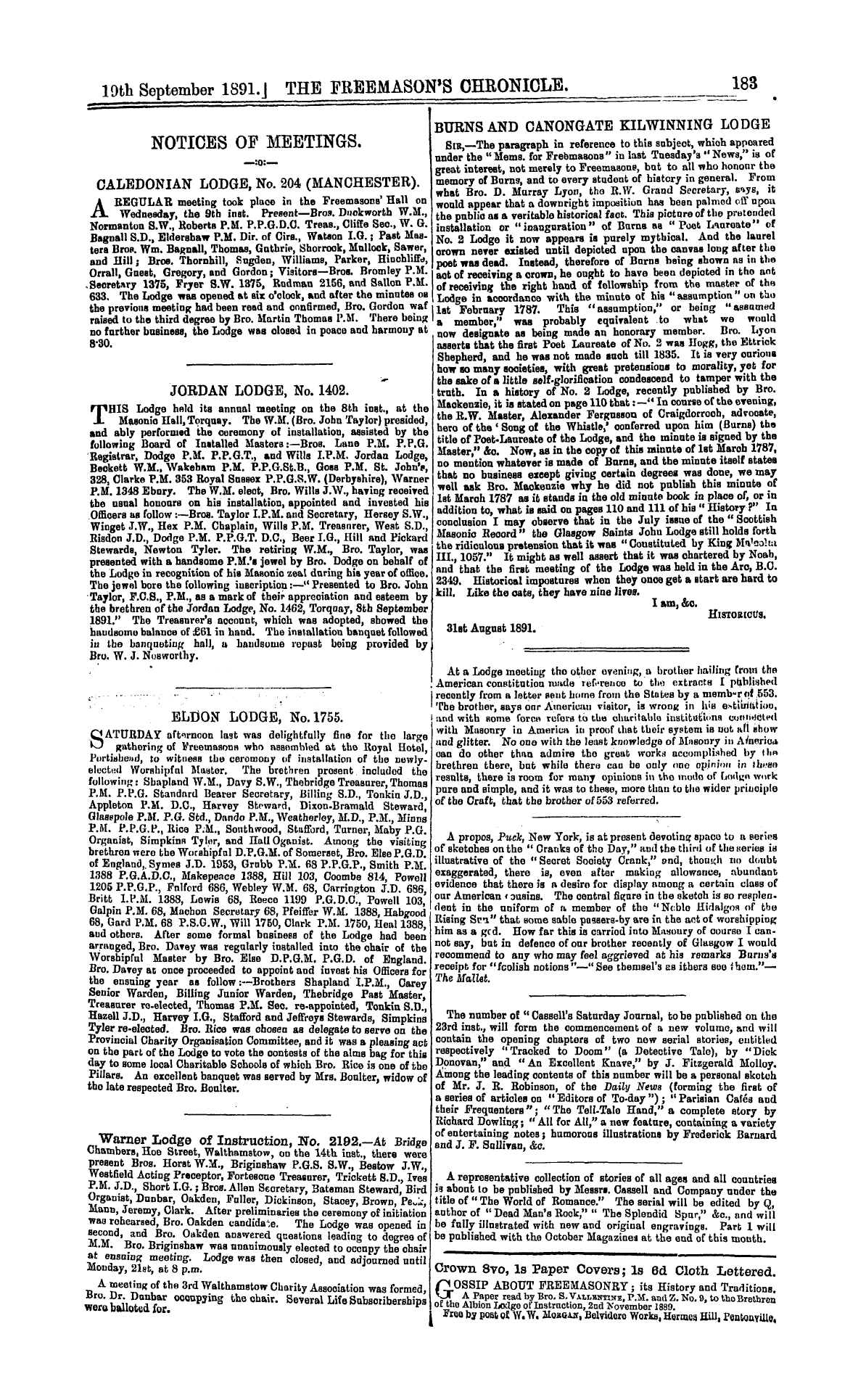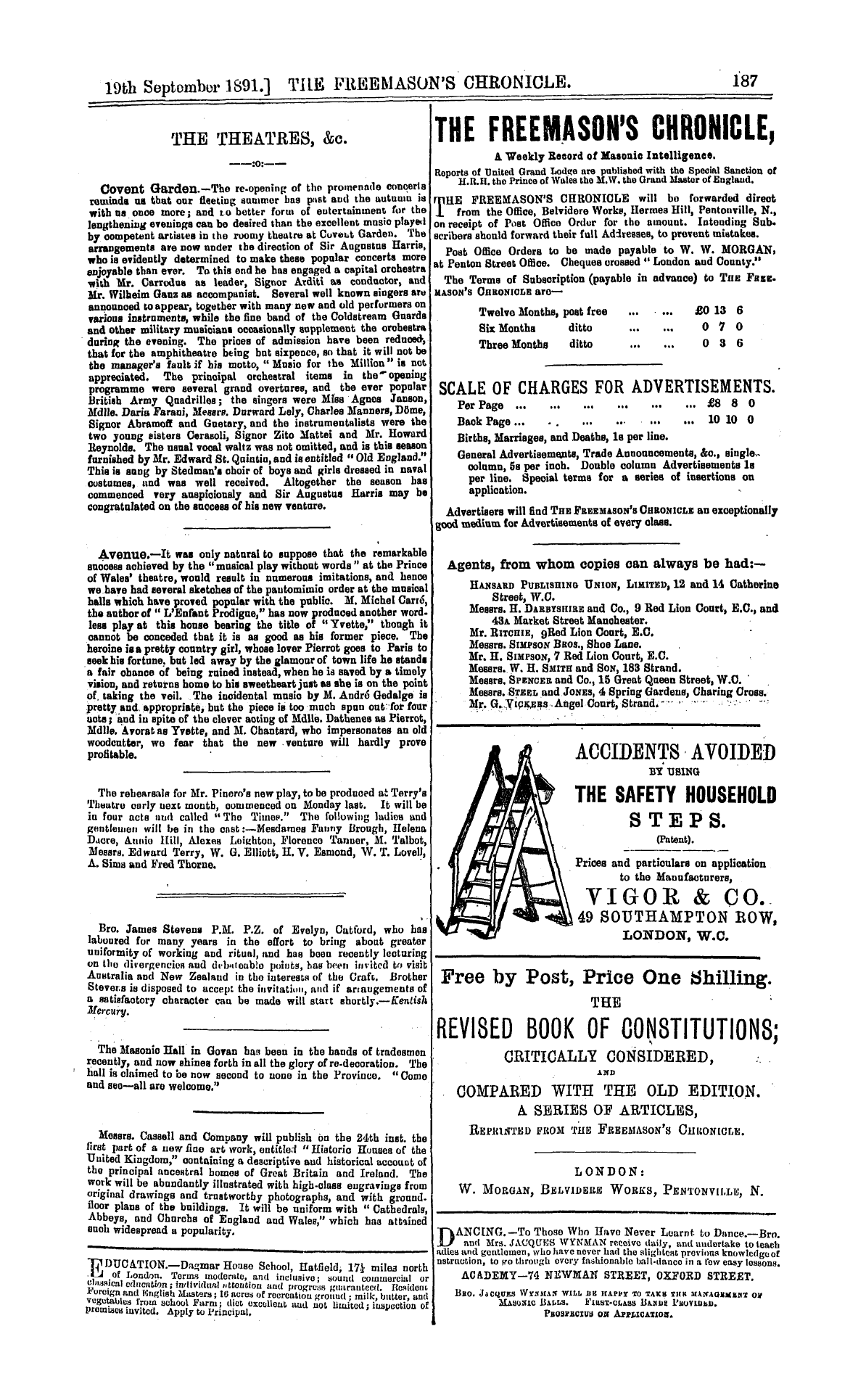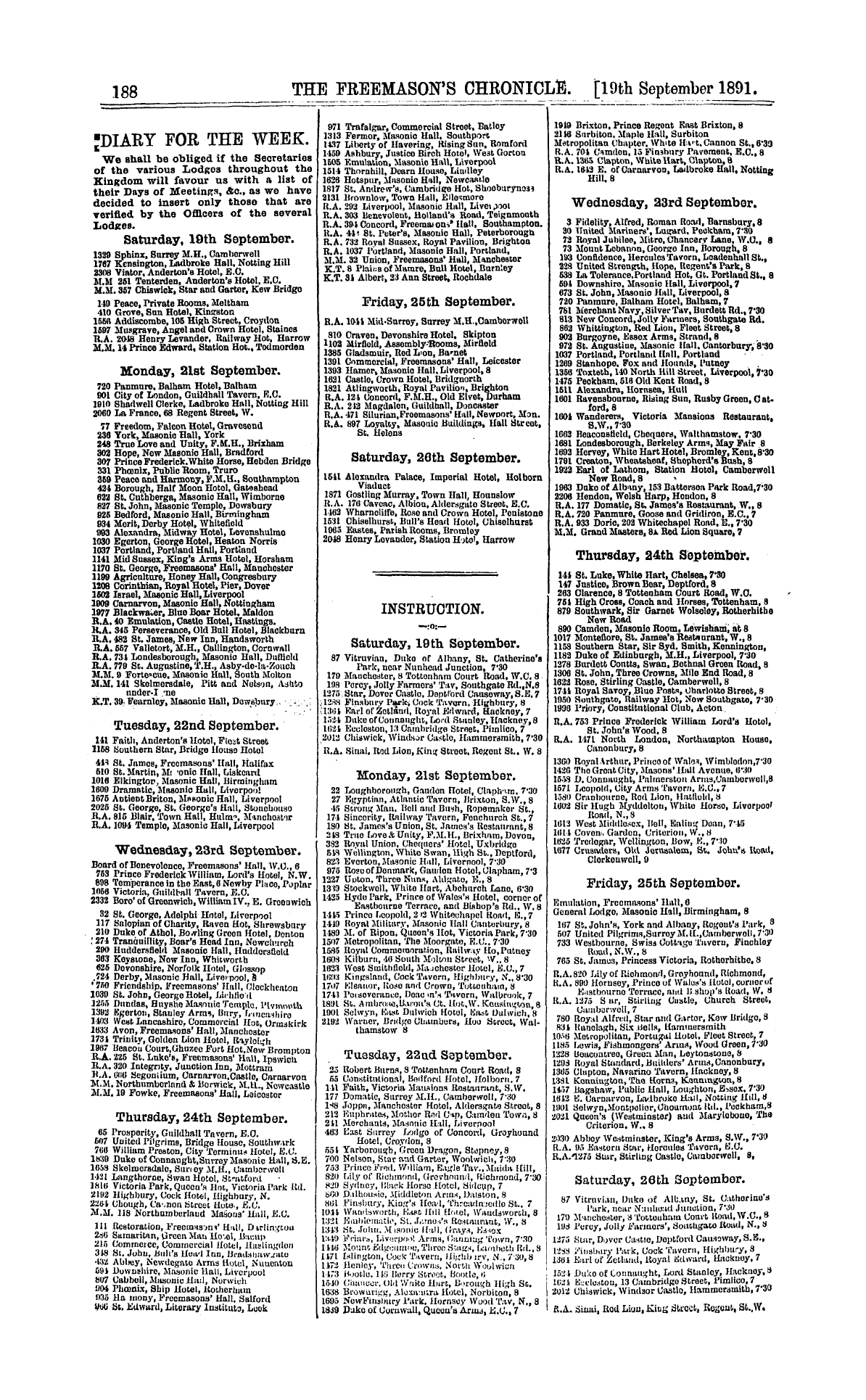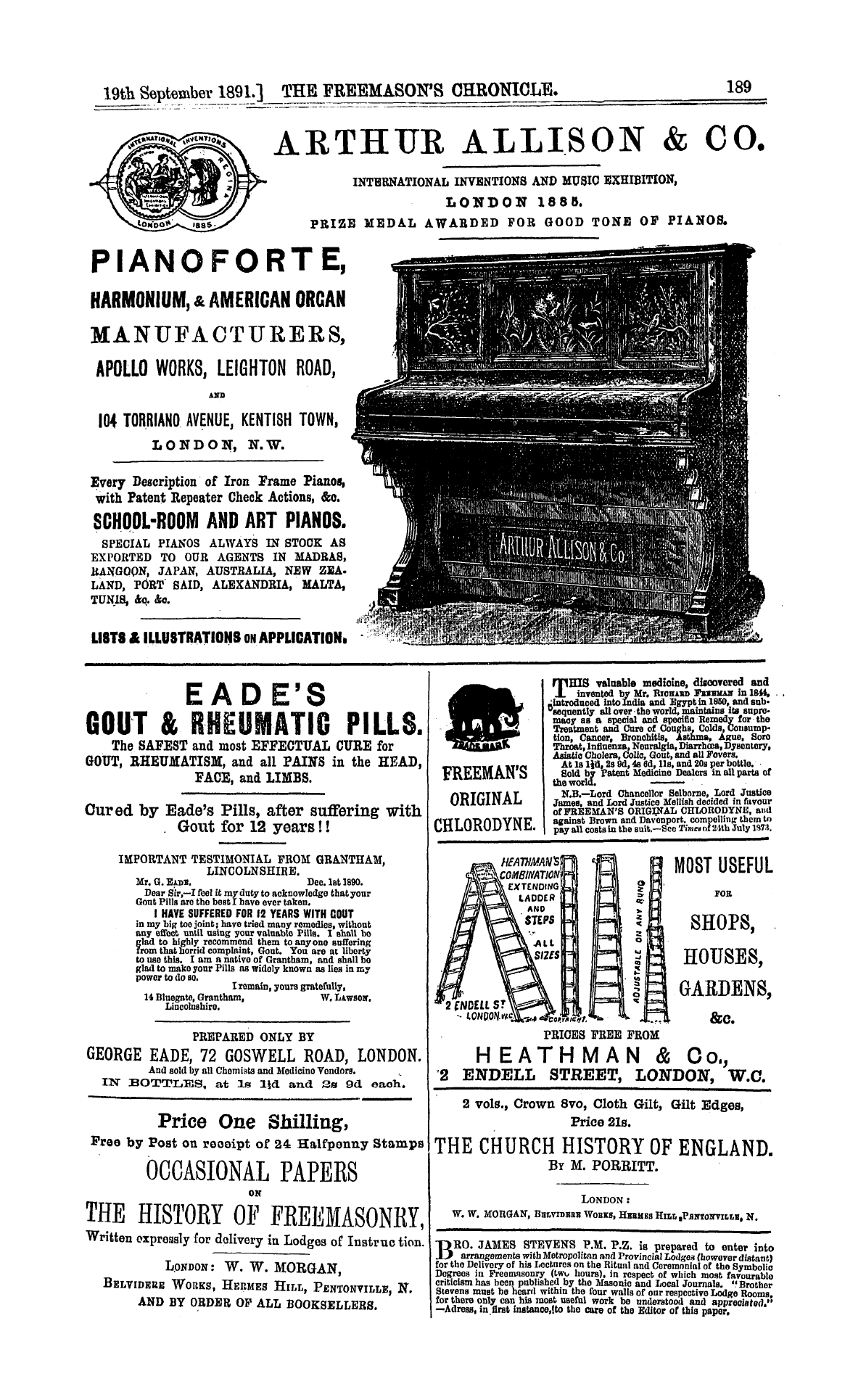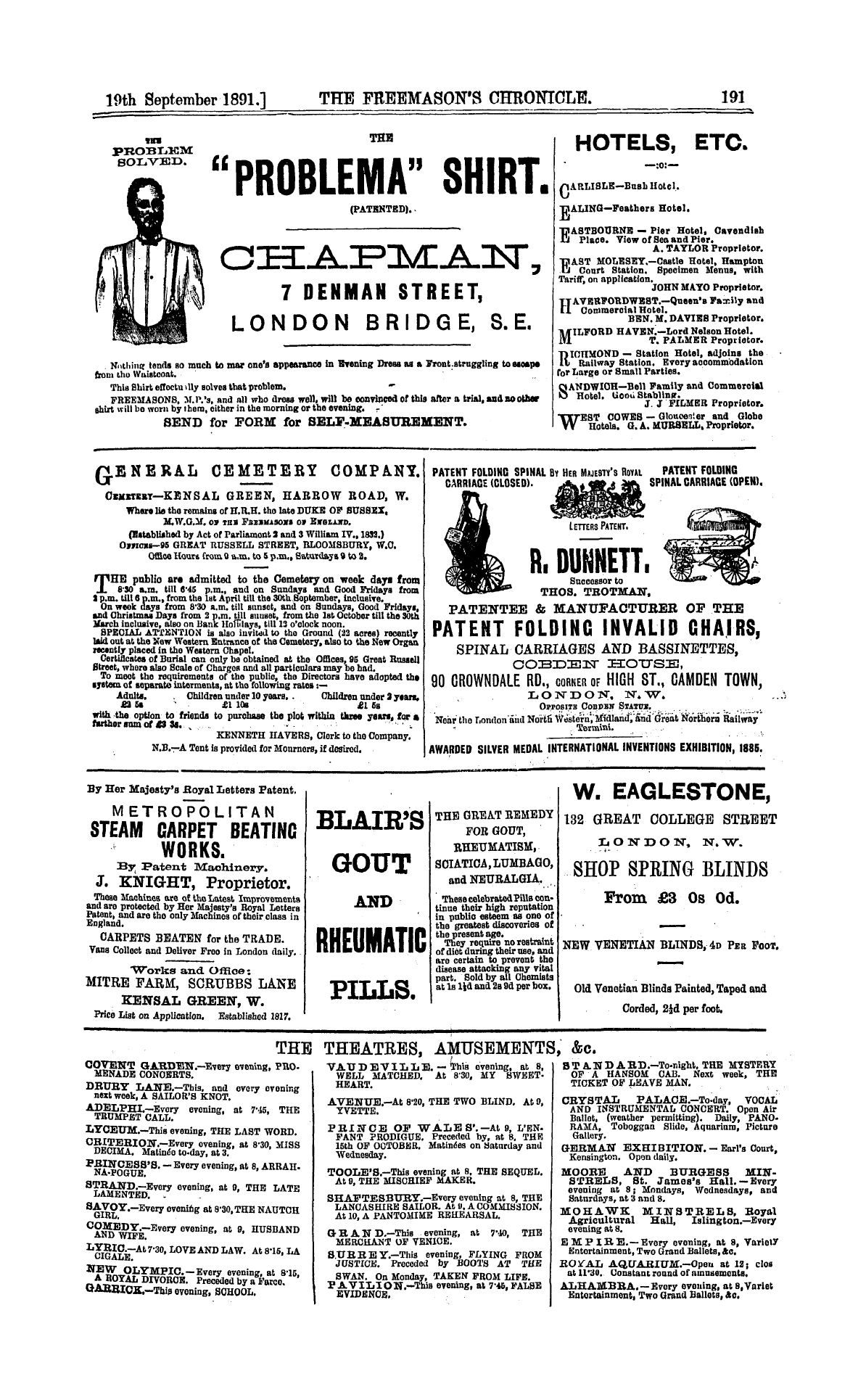-
Articles/Ads
Article THE ELECTION FOR THE BOYS' SCHOOL. ← Page 2 of 2 Article ABOUT THE NOEMAN HALL, MASONIC TEMPLE, PHILADELPHIA. Page 1 of 2 Article ABOUT THE NOEMAN HALL, MASONIC TEMPLE, PHILADELPHIA. Page 1 of 2 →
Note: This text has been automatically extracted via Optical Character Recognition (OCR) software.
The Election For The Boys' School.
jointly interested m ono ease , while Cornwall and Devon have another between them , the latter district and Somerset sharing responsibility in yet another case . Essex , Herefordshire , South Wales East , Sussex
and Worcestershire each have a single case on the list . Cumberland and Westmoreland , Staffordshire , Warwickshire and North and East Yorkshire each figure for two , while Kent brings up the rear with tllVftfl .
With the candidates thus widely spread about , and the more important districts apparently free to manipulate their voting power by loaning or exchanging proxies , it seems likely the coming struggle will bo moro than usually exciting , and it is fair to imagine that any Province which is disposed to
pledge its credit , and is in a good position to repay votes , will be able to borrow sufficient for their requirements . On the other hand it is difficult to account for the absence of candidates from some of the larger
districts we have referred to . It is idle to imagine there are none eligible , as in most , if not all of these districts , there are local funds in force , with large numbers of benefits at present being distributed , and tho rule has generally been to select some one or
more of the more deserving of these cases for transference to the Metropolitan Institutions . We do not wish to offer regrets that thore are no candidates from these parts ; on the contrary , wo are delighted to think
that the districts can provide for thoir own needs ; but we cannot help wondering whether there is any special reason to account for what must certainly be regarded as a peculiarity . Does it imply that the larger
Provinces are beginning to wean themselves from the great Charities . For years past there has been a growing desire in certain quarters to support local Funds rather than the central ones , and if the great centres of Provincial Masonry can point to an absence
of candidates for the London Charities there will be an additional incentive to induce subscriptions for local Funds . In view , however , of what the Provinces havo recently done on behalf of the Boys ' Schoolwhen thev so noblv sumiorted the Earl of / —
, - - - »/ - */ -j , x— — Lathom as Chairman of the Anniversary Festival of the Institution , wo must not Buppose that separation is aimed at or even thought of . The absence of candidates from the larger Provinces this time must
therefore be dismissed , rather as a coincidence than anything else , but it will be curious to watch the effect that will be produced in consequence of the large number of votes which will , so to speak , be available for the " open market . "
About The Noeman Hall, Masonic Temple, Philadelphia.
ABOUT THE NOEMAN HALL , MASONIC TEMPLE , PHILADELPHIA .
UNDER the most pagan of emperors in the soil of Istria was planted the seed for the development of all future Christian architecture . Up to the time of Diocletian , that great constructive feature , the arch , had been masked behind a screen of Greek detail , but in his palace at
Spalatro , the architect , departing from the usual and previously accepted formula for a portico , retained no portion of the cornice under the springing of the arch but boldly cut loose from it , placing his archivolt directly upon
the capital of the columns . The experiment proved so like a discovery that other builders adopted the example , and hence all future developments of the architecture of the arch in all countries by a process of natural retrogression date from this example .
Local modifications were broad and multifarious , but the influence of Boman art is everywhere apparent . Concurrent yet divergent movements emanating from the same source were operating upon the architecture of Eastern Europe
and Asia . Great as were the changes introduced , these changes were the direct result of analysis applied to the elements of the then existing monuments of the empire , and applied with a rationale such as never had been applied
About The Noeman Hall, Masonic Temple, Philadelphia.
previously . It was fonnd that by cutting loose from the trammels of studied proportions , whilst retaining for the most part the details , the new departure lent itself so perfectly to all conditions , was so pliable and plastic and so capable of individual expression as to find universal
favour . By giving the arch a degree of enrichment consonant with its function , great variety waa produced , and in tho history of art , the style , in view of tho various phases of the arch treatment , is known as the " Bomanesque ;"
thus we have the Bomanesque of Lombardy , tbe Bomanesque of Venice , the Bomanesque of the Bhine , the Bomanesque of Provence , the Bomanesque of Normandy and England , more familiarly known as the " Norman . "
Bomanesque architecture then may be described briefly as a style of architecture in which tho obsolete elements of the Greek and Boman orders are abandoned as primary features in view of the introduction of arched construction , which is made the feature to tho exclusion of all other
features , and its various changes until its full development into late Gothic were the result of efforts to give artistic , expression to the arched construction ; whether as round , pointed or vaulted , the effort was to lead up to and concentrate upon tho arch , as upon the key of the entire
composition , the best efforts of the master . Bomanesque architecture succeeded in attaining suoh an expression , in the simpler construction of its arcades and openings in walls ; Gothic attained it in tho more complex construction
of its vaulted spaces and in the span of its traceried windows . Bomanesque , as also the Gothic , is tho architecture of tho equilibrium of forces , as opposed to tho inertia of the trabeated architecture of the Greeks .
A cursory glance at the earliest of the Bomanesque buildings , taken at random , evidences the perfect freedom of the designer , classically proportioned parts are disregarded , columns and pillars are made to any length required by their position , grouped , clustered or banded
together as the case suggests , differentiated in view of the structure it supports , or , if purely decorative , prolonged to an indefinite length , or used as nook shafts to accentuate the angles of wall or pier or to carry down tho line of somo prominent arch features . The capitals in the early
examples imitate very closely classic models ; latterly they were more commonly cushion shaped , often ornamonted with representations of the grotesque or with Scriptural imagery , and these sometimes , though rarely , harshly contrasted with the devices commonly connected—varying
with tho country—with some former cult . Nature supplied models for most of tho elaboration of parts , whilst the chevron and dog-tooth , so characteristic of tho Bomanesque of Normandy and England , was made to serve as decoration for the column and arch mouldings .
Base mouldings , string courses , . cornices and gables , approximate to classic models in tho early examples , but in the later structures—except in Provence , the land of tho Romance , where the influence of Borne held until very
lately permanent sway—more or less of individual freedom is manifested , until the details became unique and had no apparent connection with anything that had gone before , —it had become localized .
In decoration , as applied to Masonry , mosaics , textile fabrics and glass , the models for a long time were obtained from the pagan world ; the aureole of Christ was contrasted with the embroidered vestments of a Byzantine Emperor until the inconsistency dawning upon later artists invested
Him with the habiliments peculiar to their own time . The colours employed were the primaries and secondaries , with white and black as contrasts , enrichments of great beauty being obtained by the lavish use of precious medals , rare stones and gems . Windows , at first small
then gradually larger , presented an involved mixture of interlacing ornament intertwining through the limbs of saints , martyrs , and mythical monsters , heathen and Christian imagery strangely contrasting . In drawing , tho conventional treatment of the human figure was more or
less rude ; they were flat and in outline , except sometimes the face , upon which alone there was any attempt at modelling ; they were nevertheless striking , brilliant colouring being heightened by contrast with gilded mosaic
background or of foil applied directly to the wall surfaces . Sculptured human figures and animal life were even more conventional , the drapery of the former being harsh and angular . The characteristics of style above outlined applies to the Norman Hall of the Masonic Temple , though , properly
speaking , the style is Rhenish Romanesque , but the term
Note: This text has been automatically extracted via Optical Character Recognition (OCR) software.
The Election For The Boys' School.
jointly interested m ono ease , while Cornwall and Devon have another between them , the latter district and Somerset sharing responsibility in yet another case . Essex , Herefordshire , South Wales East , Sussex
and Worcestershire each have a single case on the list . Cumberland and Westmoreland , Staffordshire , Warwickshire and North and East Yorkshire each figure for two , while Kent brings up the rear with tllVftfl .
With the candidates thus widely spread about , and the more important districts apparently free to manipulate their voting power by loaning or exchanging proxies , it seems likely the coming struggle will bo moro than usually exciting , and it is fair to imagine that any Province which is disposed to
pledge its credit , and is in a good position to repay votes , will be able to borrow sufficient for their requirements . On the other hand it is difficult to account for the absence of candidates from some of the larger
districts we have referred to . It is idle to imagine there are none eligible , as in most , if not all of these districts , there are local funds in force , with large numbers of benefits at present being distributed , and tho rule has generally been to select some one or
more of the more deserving of these cases for transference to the Metropolitan Institutions . We do not wish to offer regrets that thore are no candidates from these parts ; on the contrary , wo are delighted to think
that the districts can provide for thoir own needs ; but we cannot help wondering whether there is any special reason to account for what must certainly be regarded as a peculiarity . Does it imply that the larger
Provinces are beginning to wean themselves from the great Charities . For years past there has been a growing desire in certain quarters to support local Funds rather than the central ones , and if the great centres of Provincial Masonry can point to an absence
of candidates for the London Charities there will be an additional incentive to induce subscriptions for local Funds . In view , however , of what the Provinces havo recently done on behalf of the Boys ' Schoolwhen thev so noblv sumiorted the Earl of / —
, - - - »/ - */ -j , x— — Lathom as Chairman of the Anniversary Festival of the Institution , wo must not Buppose that separation is aimed at or even thought of . The absence of candidates from the larger Provinces this time must
therefore be dismissed , rather as a coincidence than anything else , but it will be curious to watch the effect that will be produced in consequence of the large number of votes which will , so to speak , be available for the " open market . "
About The Noeman Hall, Masonic Temple, Philadelphia.
ABOUT THE NOEMAN HALL , MASONIC TEMPLE , PHILADELPHIA .
UNDER the most pagan of emperors in the soil of Istria was planted the seed for the development of all future Christian architecture . Up to the time of Diocletian , that great constructive feature , the arch , had been masked behind a screen of Greek detail , but in his palace at
Spalatro , the architect , departing from the usual and previously accepted formula for a portico , retained no portion of the cornice under the springing of the arch but boldly cut loose from it , placing his archivolt directly upon
the capital of the columns . The experiment proved so like a discovery that other builders adopted the example , and hence all future developments of the architecture of the arch in all countries by a process of natural retrogression date from this example .
Local modifications were broad and multifarious , but the influence of Boman art is everywhere apparent . Concurrent yet divergent movements emanating from the same source were operating upon the architecture of Eastern Europe
and Asia . Great as were the changes introduced , these changes were the direct result of analysis applied to the elements of the then existing monuments of the empire , and applied with a rationale such as never had been applied
About The Noeman Hall, Masonic Temple, Philadelphia.
previously . It was fonnd that by cutting loose from the trammels of studied proportions , whilst retaining for the most part the details , the new departure lent itself so perfectly to all conditions , was so pliable and plastic and so capable of individual expression as to find universal
favour . By giving the arch a degree of enrichment consonant with its function , great variety waa produced , and in tho history of art , the style , in view of tho various phases of the arch treatment , is known as the " Bomanesque ;"
thus we have the Bomanesque of Lombardy , tbe Bomanesque of Venice , the Bomanesque of the Bhine , the Bomanesque of Provence , the Bomanesque of Normandy and England , more familiarly known as the " Norman . "
Bomanesque architecture then may be described briefly as a style of architecture in which tho obsolete elements of the Greek and Boman orders are abandoned as primary features in view of the introduction of arched construction , which is made the feature to tho exclusion of all other
features , and its various changes until its full development into late Gothic were the result of efforts to give artistic , expression to the arched construction ; whether as round , pointed or vaulted , the effort was to lead up to and concentrate upon tho arch , as upon the key of the entire
composition , the best efforts of the master . Bomanesque architecture succeeded in attaining suoh an expression , in the simpler construction of its arcades and openings in walls ; Gothic attained it in tho more complex construction
of its vaulted spaces and in the span of its traceried windows . Bomanesque , as also the Gothic , is tho architecture of tho equilibrium of forces , as opposed to tho inertia of the trabeated architecture of the Greeks .
A cursory glance at the earliest of the Bomanesque buildings , taken at random , evidences the perfect freedom of the designer , classically proportioned parts are disregarded , columns and pillars are made to any length required by their position , grouped , clustered or banded
together as the case suggests , differentiated in view of the structure it supports , or , if purely decorative , prolonged to an indefinite length , or used as nook shafts to accentuate the angles of wall or pier or to carry down tho line of somo prominent arch features . The capitals in the early
examples imitate very closely classic models ; latterly they were more commonly cushion shaped , often ornamonted with representations of the grotesque or with Scriptural imagery , and these sometimes , though rarely , harshly contrasted with the devices commonly connected—varying
with tho country—with some former cult . Nature supplied models for most of tho elaboration of parts , whilst the chevron and dog-tooth , so characteristic of tho Bomanesque of Normandy and England , was made to serve as decoration for the column and arch mouldings .
Base mouldings , string courses , . cornices and gables , approximate to classic models in tho early examples , but in the later structures—except in Provence , the land of tho Romance , where the influence of Borne held until very
lately permanent sway—more or less of individual freedom is manifested , until the details became unique and had no apparent connection with anything that had gone before , —it had become localized .
In decoration , as applied to Masonry , mosaics , textile fabrics and glass , the models for a long time were obtained from the pagan world ; the aureole of Christ was contrasted with the embroidered vestments of a Byzantine Emperor until the inconsistency dawning upon later artists invested
Him with the habiliments peculiar to their own time . The colours employed were the primaries and secondaries , with white and black as contrasts , enrichments of great beauty being obtained by the lavish use of precious medals , rare stones and gems . Windows , at first small
then gradually larger , presented an involved mixture of interlacing ornament intertwining through the limbs of saints , martyrs , and mythical monsters , heathen and Christian imagery strangely contrasting . In drawing , tho conventional treatment of the human figure was more or
less rude ; they were flat and in outline , except sometimes the face , upon which alone there was any attempt at modelling ; they were nevertheless striking , brilliant colouring being heightened by contrast with gilded mosaic
background or of foil applied directly to the wall surfaces . Sculptured human figures and animal life were even more conventional , the drapery of the former being harsh and angular . The characteristics of style above outlined applies to the Norman Hall of the Masonic Temple , though , properly
speaking , the style is Rhenish Romanesque , but the term






